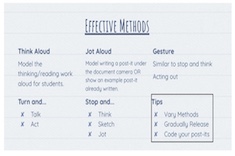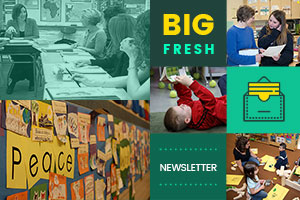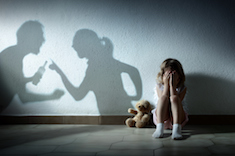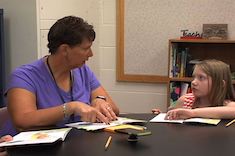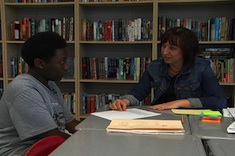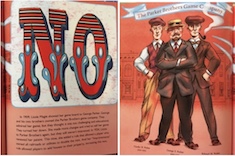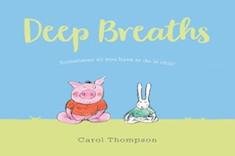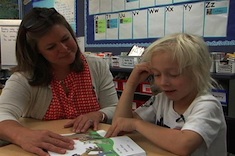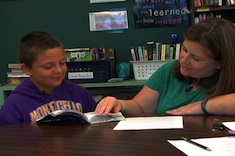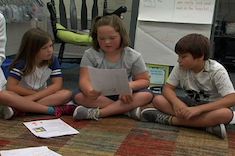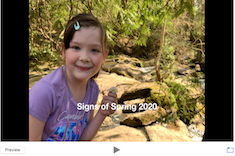Library
Choice Literacy Articles & Videos
The Choice Literacy library contains over 3,000 articles and 900 videos from 150+ contributors. Classic Classroom and Literacy Leadership subscribers have access to the entire library. Content is updated continuously, with five to six new features published each week.
Latest Content
Digital Interactive Read Alouds
Tara Barnett and Kate Mills share everything from useful prompts to the best tech tools for moving interactive read alouds to digital platforms during remote instruction.
October 2, 2020 The Kind of Teacher Who Cares
Strategic small groups is the theme of this week’s newsletter.
Issues Overload
Shari Frost finds that the issues students may be dealing with in some children’s books can be overwhelming. She shares some of her favorite books for grappling with one troubling topic at a time.
Changing How I Teach Small Groups
Tammy Mulligan listens to students and adapts her small-group instruction as they share how they learn.
Guided Reading Part 1: Previewing and Skills
This is the first guided reading group in September for Cheryl Miller. She begins the lesson by previewing the book and reminding students of the skills they are working on. This is the first video in a three-part series.
September 25, 2020 Pygmalion Syndrome
Rethinking standards is the theme of this week’s newsletter.
Matching Evidence and Claims in Writing
Christy Rush-Levine confers with Brendan about his literary analysis and how to match evidence and claims. She has him talk through his understanding of the text, using the oral rehearsal to plan his writing.
Learning Standards: No Best Way
Jen Schwanke provides some critical questions for teachers to ask when they are interpreting a standard and bringing it to life with students.
Data That We Can Trust
Matt Renwick finds the data closest to the students we serve is more helpful to teachers than many benchmarks or screener scores.
Preparing for Book Club Discussions
Tara Barnett and Kate Mills find that book clubs succeed when students are given thoughtful tools to prepare for them.
September 18, 2020 Going Rogue
Picture books is the theme of this week’s newsletter.
See Your Students
Shari Frost explains why the simple act of “seeing” students can have such a potent effect in building a community of learners.
Using Picture Books for Rhetorical Analysis
Gretchen Schroeder finds that picture books are the perfect tool for rhetorical analysis with her high school students.
Picture Books for Mental Wellness
Mandy Robek learns a lot about worry from her daughter, and discovers a treasure trove of picture books to promote mental wellness and help students cope with difficult emotions.
Using Pictures to Decode in First Grade
Bitsy Parks helps first grader Zac work on his decoding skills by using a fun picture book.
September 11, 2020 Florence Genevieve Saperstein
Choice is the theme of this week’s newsletter.
Fifth-Grade Reading Conference: Harry Potter
Katherine Sokolowski confers with fifth grader Tucker about his Harry Potter book. This brief conference includes connections to the movies, recommendations for a classmate, and suggestions for using an audiobook on a trip so that the whole family can enjoy it.
Choice in Literacy Workshops
What makes choice authentic in literacy workshops? Christy Rush-Levine grapples with this tough question that leads to changes in her instruction.
Nurturing Independent Reading Lives in Middle School
Tara Barnett and Kate Mills share their favorite strategies for building a classroom community of readers where everyone has several options for choosing their next book.
September 4, 2020 A Specific No
Thoughtful reading response is the focus of this week’s newsletter.
Socratic Discussion in Third Grade
Lora Bieghler facilitates a Socratic-style discussion among third graders.
Fostering Cultural Awareness Through Book Clubs
Gretchen Schroeder’s students are almost all white and live in a rural community. She finds book clubs are a wonderful tool for expanding cultural awareness.
Fourth-Grade Reading Group: Goals in Fiction
Gigi McAllister leads a group of fourth graders in discussing characters and their quests or goals in the story.
Meet Someone New Monday: Using Picture Book Biographies to Bring Marginalized Voices into the Classroom
Melissa Quimby creates “Meet Someone New Monday” to inspire students with picture book biographies of little-known artists, activists, and citizens who accomplish remarkable feats.
Flipping Literature Discussions
Gretchen Schroeder realizes her experiences from decades ago as a student are clouding her perspective on “flipped” literature discussions. Once she gets over her biases, she finds that online discussion of literature is a powerful equalizer for student voices.
August 28, 2020 Don’t Talk About My Writing Without Me
Giving feedback online is the focus of this week’s newsletter.
Building Online Writing Groups
Leigh Anne Eck lists critical questions teachers might ask themselves as they build online writing communities where everyone is comfortable giving and receiving feedback.
Using Photographs in Remote Learning Communities
Bitsy Parks shares how she and her first-grade students used photography to bridge the distance between home and school this spring, learning lessons she is using this fall in remote learning contexts.
Three Things Digital Tools Have Taught Me About Feedback
Christy Rush-Levine discovers that a move to digital feedback reveals many important truths about her middle school students, including insights into the effect of grades on how learners view response to their work.
August 21, 2020 Future Focused
This week we look at how to build and sustain remote learning communities.
Browse Content By
Type
Category
- Assessment Tools
- Big Fresh Archives
- Booklists
- Choice Numeracy
- Classroom Design
- Common Core
- Community Building
- Conferring
- Content Literacy
- Digital Literacy
- English Language Learners
- Equity
- Family Relations
- Free Samples
- Guiding Groups
- Leadership
- Literacy Coaches
- Mentor Texts
- Minilessons
- New Teacher Mentors
- Podcasts
- Poetry
- Quote Collections
- Reading Strategies
- Self Care
- Struggling and Striving Learners
- Talking and Listening
- Teacher Study Groups
- Teaching Reading
- Teaching Writing
- Word Study and Vocabulary
Author
- Melissa Quimby
- Nawal Qarooni
- Gwen Blumberg
- Julie Cox
- The Lead Learners
- Hannah Tills
- Josie Stewart
- Ruth Metcalfe
- Mallory Messenger
- Becca Burk
- Jodie Bailey
- Vivian Chen
- Mary Brower
- Tiffany Abbott Fuller
- Stephanie Affinito
- Ruth Ayres
- Leigh Anne Eck
- Heather Fisher
- Shari Frost
- Julie Johnson
- Suzy Kaback
- Gigi McAllister
- Shirl McPhillips
- Melanie Meehan
- Cathy Mere
- Debbie Miller
- Tara Barnett and Kate Mills
- Tammy Mulligan
- Dana Murphy
- Bitsy Parks
- David Pittman
- Brenda Power
- Heather Rader
- Matt Renwick
- Mandy Robek
- Christy Rush-Levine
- Gretchen Schroeder
- Jen Schwanke
- Brian Sepe
- Katherine Sokolowski
- Stella Villalba
- Jennifer Vincent
Grade Level
Choice Literacy Membership
Articles
Get full access to all Choice Literacy article content
Videos
Get full access to all Choice Literacy video content
Courses
Access Choice Literacy course curriculum and training

